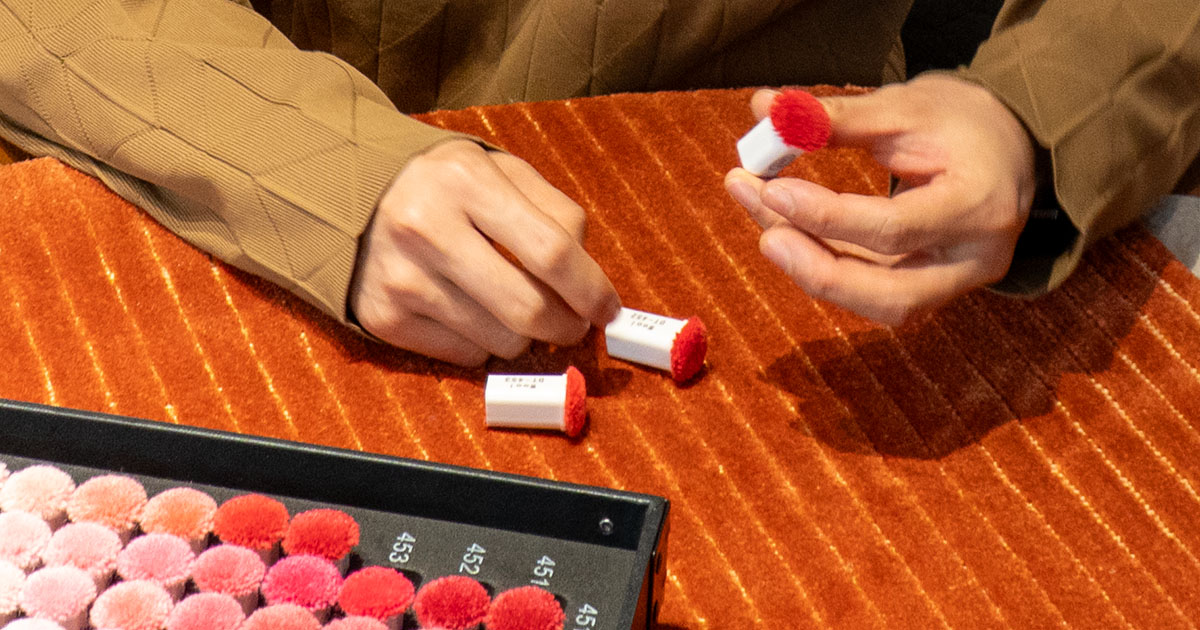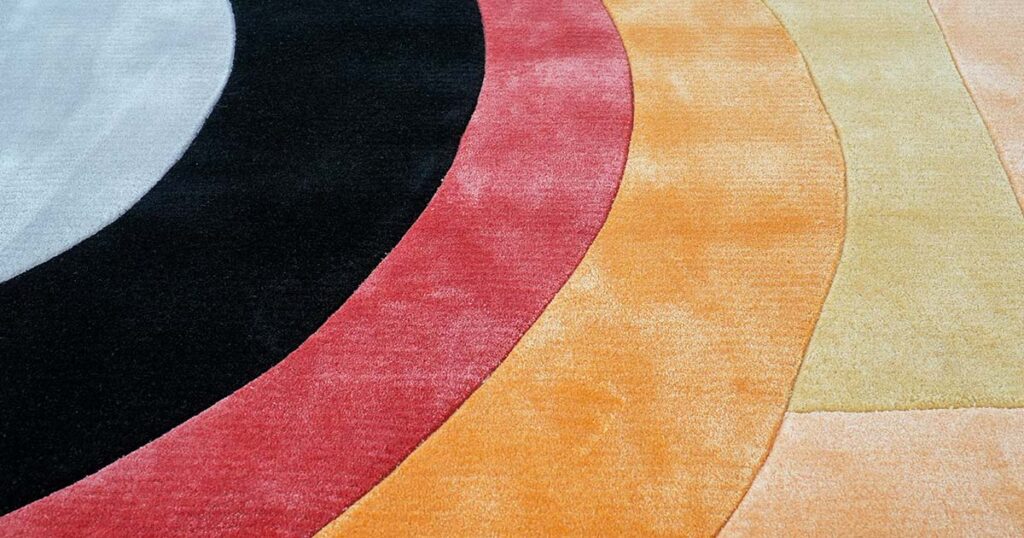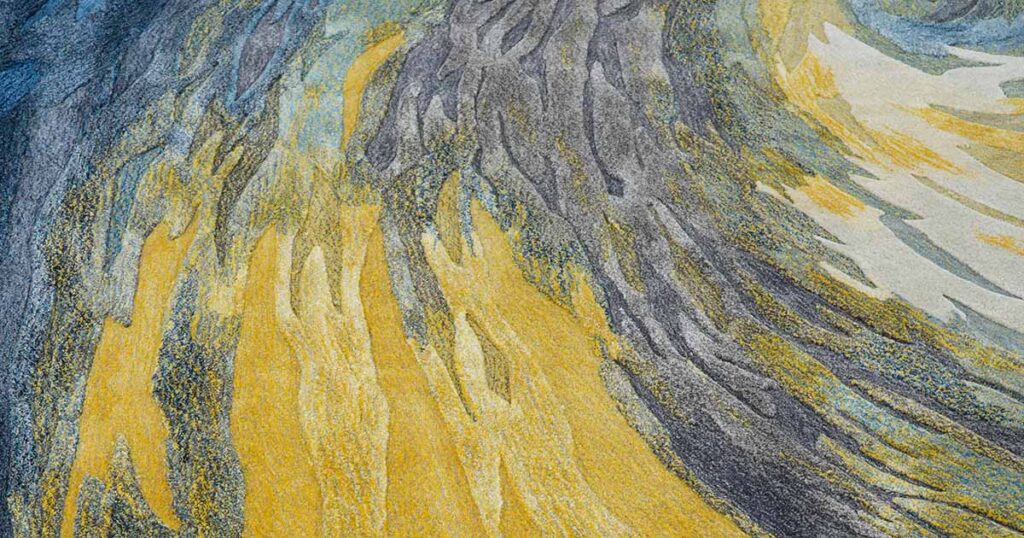Custom tufted rugs offer an excellent opportunity to enhance commercial spaces through thoughtful color choices.
Whether you’re designing for a hotel lobby, corporate office, retail space, or residential setting, understanding color pairing principles helps create spaces that both impress and function effectively.
Understanding Color Theory Basics
The foundation of successful rug color pairing starts with the color wheel – a visual tool showing relationships between colors.
The color wheel consists of primary colors (red, blue, yellow), secondary colors (green, orange, purple) made by mixing two primaries, and tertiary colors made by mixing primary and secondary colors.
Before diving into specific combinations, let’s review some key concepts:
Warm vs. Cool Colors
Warm colors (reds, oranges, yellows) create energizing, inviting environments.
In commercial settings, warm-toned rugs can make large hotel lobbies feel more intimate or retail spaces more engaging.
Cool colors (blues, greens, purples) deliver a calming, professional atmosphere.
These work exceptionally well in office environments, healthcare facilities, and museum spaces where a serene ambiance is desired.
The psychological impact matters tremendously in commercial spaces.
A hotel restaurant might benefit from warm tones to stimulate appetite and conversation, while a spa lounge would better serve clients with cool, tranquil hues.
Contrast vs. Harmony
Successful rug designs balance visual interest (contrast) with cohesiveness (harmony):
High contrast rugs, like those with bold black and white patterns, become dramatic focal points – perfect for statement areas in hotel lobbies or retail entrances.
Harmonious designs use related colors for a more subtle, unified presence.
A museum might prefer a harmonious rug with minimal contrast to avoid competing with exhibits.
Most effective commercial rugs employ strategic contrast against a harmonious base.
- For example, an office carpet might feature mainly harmonious blues with a contrasting accent stripe in the company’s signature color.
The Psychology of Color
Colors evoke specific moods and emotions that can strategically influence commercial environments:
- Red – excitement, passion, energy
- Orange – enthusiasm, warmth, vibrancy
- Yellow – happiness, optimism, creativity
- Green – balance, harmony, renewal
- Blue – calm, serenity, stability
- Purple – luxury, spirituality, sophistication
- Brown – comfort, security, earthiness
- Gray – sophistication, formality
- Black – power, elegance, mystery
- White – purity, cleanliness, simplicity
In commercial settings, these psychological effects can influence customer behavior and employee productivity.
A retail store might use energetic red accents to encourage purchases, while a corporate office might employ calming blues to create a focused work environment.
Key Color Pairing Approaches
Monochromatic Color Schemes
Monochromatic schemes use variations in lightness and saturation of a single hue. This creates sophisticated, cohesive spaces through simplicity.
Benefits include:
- Versatility – works with any color
- Simplicity – easy to coordinate with other elements
- Serenity – soothing, not overstimulating
- Elegance – timeless, classic look
A museum or gallery might install monochromatic gray carpeting with subtle texture variations. The unified color doesn’t compete with artwork, while varying pile heights create visual interest through shadow and light play.
Modern office environments often employ monochromatic schemes (all-charcoal or all-beige) for a clean, expansive feel, relying on furniture and branding elements to add color.
For practical reasons, commercial monochromatic rugs typically use mid-tones rather than light colors to withstand foot traffic and conceal soil.
Complementary Color Schemes
Complementary schemes pair colors from opposite sides of the color wheel (blue & orange, red & green, yellow & purple). This creates maximum contrast and visual energy.
In commercial applications, it’s typically best to let one color dominate and use the complementary color as an accent.
A retail floor might be primarily cool blue-gray (70-80%) with geometric patterns in orange (20-30%) to create visual interest without overwhelming the space.
Tips for using complementary colors in commercial rugs:
- Choose one color to dominate, use the other as an accent
- Vary the shades – e.g., dark blue with light orange
- Balance with neutrals to avoid too much intensity
- Consider the undertones for more sophisticated pairings
Many corporate color schemes intentionally use complementary contrasts for high visibility. A custom office lobby rug might incorporate company colors, even if they’re opposites, to reinforce branding.
Analogous Color Schemes
Analogous schemes use colors adjacent on the color wheel (like blue, teal, and green). This approach creates cohesive, pleasing environments perfect for spaces requiring a specific mood.
Benefits of analogous rugs in commercial spaces:
- Soothing, pleasing to the eye
- Easy to coordinate with decor
- Work well with both warm and cool color families
- Can be vibrant or subdued
A hotel lounge might use oceanic analogous colors (blues and blue-greens) to reinforce tranquility, while an office could select analogous tones matching their branding.
To prevent analogous schemes from appearing flat, vary the lightness or saturation within your color family. Let one color dominate (approximately 60%) with others in supporting roles.
Triadic Color Schemes
Triadic schemes use three evenly spaced colors on the wheel, like red, yellow, blue. They are vibrant, dynamic and balanced.
In commercial rug applications:
- Use one color predominantly, others as accents
- Vary shades and tints for depth
- Balance with neutrals
- Consider muted triadic combinations for sophistication
Triadic rugs make bold statements in hotel lobbies, creative agency offices, or retail environments targeting younger demographics.
Using Accent Colors Effectively
Accent colors add visual interest to otherwise controlled color schemes. The classic 60-30-10 rule (60% dominant color, 30% secondary, 10% accent) provides a useful framework.
In commercial spaces, accent colors often reinforce branding or thematic elements. A conference room might feature primarily gray carpet tiles with a few tiles in the company’s signature green to add interest and brand identity.
A boutique hotel might use a mostly neutral rug with small accent patterns matching decorative elements elsewhere in the space, creating coherence across the design.
New Zealand Wool: Superior Medium for Colors
Custom tufted rugs commonly use New Zealand wool, and for good reason.
This premium material offers significant advantages for color application:
Rich Color Depth
Wool’s complex protein structure readily accepts dyes and locks in color. Commercial spaces benefit from wool’s exceptional color-fastness – maintaining vibrant hues even in high-traffic areas like hotel lobbies.
Natural Luster
Wool has a gentle sheen that makes colors appear more luxurious. A navy wool rug isn’t a flat blue – the fiber’s light-reflecting properties add depth that synthetic materials can’t match.
Textural Dimension
Wool’s varied textures (cut pile, loop pile, sculpted) interact with light differently, creating tonal effects even within a single color. A monochromatic wool rug gains interest through texture alone.
Practical Durability
Wool maintains its appearance through crushing and wear, keeping colors vibrant and patterns crisp over years of commercial use. Its natural soil resistance keeps colors looking fresh with regular maintenance.
Considering Existing Color Scheme
When selecting rug colors for commercial spaces, consider:
- Wall color and finishes
- Large furniture pieces and fixtures
- Upholstery and window treatments
- Branding elements and signage
- Adjacent spaces in open floor plans
Tips for commercial designers:
- Pull colors from brand guidelines for consistency
- Use the rug to tie disparate elements together
- Consider the color’s undertone for cohesion with existing elements
- Use rugs to define zones in open spaces through color differentiation
2025 Color Trends
While timeless color combinations form the foundation of good design, awareness of current trends can keep commercial spaces feeling fresh and relevant.
For 2025, we’re seeing a shift toward warm, earthy sophistication.
Rich coffee and caramel tones are bringing grounded luxury to interiors, while nuanced neutrals with character are replacing stark grays and whites.
Other notable trends include:
- Deep, rich tones in the neutral family (warm blacks and near-blacks)
- Spice-inspired colors (cinnamon, ochre, mustard)
- Gentle botanical pastels like mauve for accents
Commercial applications might incorporate these trends through:
- Rich brown base rugs with gold accents in luxury hotels
- Nuanced neutrals with character in office environments
- Strategic use of trendy accent colors in retail and hospitality
Pairing Colors Based on Commercial Space Type
Different commercial environments have distinct color requirements:
Traditional Corporate Settings
Rich, saturated jewel tones
Warm color palette with burgundies, navy, brown
Accented with creams, sage, gold
Often incorporate brand colors strategically
Modern/Creative Workspaces
Bright, clear hues
Cool color palette with blues, greens, purples
Accented with white, gray, black
Bold, geometric patterns that energize
Hospitality Environments
Soft, muted colors for guest comfort
Mix of warm and cool – e.g., moss green with terracotta
Accented with ivory, camel, gray
Subtle patterns that wear well
Retail Spaces
Dynamic, attention-grabbing combinations
Brand-aligned color schemes
Strategic use of contrast to direct customer flow
Durable colors that maintain appearance with heavy foot traffic
Commercial Application Examples
Hotel Lobby
A grand hotel lobby with marble and wood might benefit from a warm analogous scheme – perhaps deep burgundy (60%), rusty orange (30%), and golden yellow accents (10%) in an ornate pattern. These warm colors create a welcoming, luxurious atmosphere that complements wood tones and metallic fixtures.
Corporate Office
A modern office lobby could use a monochromatic approach with strategic brand accents. Gray-blue carpet tiles (90%) with occasional insets in the company’s signature orange (10%) maintain professionalism while reinforcing brand identity.
Retail Boutique
A fashion boutique might employ a complementary scheme for visual energy – soft teal blue as the background with coral/peach accents. The teal provides a calming backdrop that allows merchandise to shine, while coral accents add vibrancy and guide customer movement.
Museum Gallery
Museums typically benefit from neutral monochromatic schemes that don’t compete with exhibits. A high-quality wool carpet in varying tones of gray-beige provides a sophisticated foundation, with the option to add temporary accent rugs for specific exhibitions.
Timeless Color Combinations
For commercial spaces requiring longevity, certain color combinations have proven consistently effective:
Neutral Foundations
Grays, taupes, beiges and creams create versatile bases that adapt to changing décor elements. These work particularly well in spaces updated frequently, like hotel rooms.
Classic Blues
Navy, denim, and blue-gray act almost as neutrals but with more visual interest. They convey calm and trustworthiness – perfect for corporate or governmental settings.
Black and White
High-contrast neutral combinations remain perennially chic for signature spaces. These stark contrasts transcend trends while creating visual impact.
Heritage Combinations
Deep reds with navy and ivory – inspired by traditional Persian designs – have decorated floors for centuries and remain relevant across global markets.
Residential Applications
While our focus is commercial, these principles translate beautifully to residential settings:
- A home office might employ the same strategic brand color accents as a corporate space, just scaled appropriately
- Living rooms can benefit from timeless color combinations like navy and gold for longevity
- Dining areas might use warm tones similar to restaurant designs to create convivial atmospheres
Conclusion
Thoughtful color pairing for custom tufted rugs creates commercial spaces that impress visitors, reinforce branding, and serve functional needs.
By understanding color theory fundamentals and applying them with New Zealand wool’s superior color capabilities, you can design rugs that enhance any environment.
Whether you’re creating a luxurious hotel experience, a professional office atmosphere, or an engaging retail environment, the right color combinations will ground your space in both beauty and purpose.
The key is to experiment and trust your instincts while keeping your commercial objectives in mind.









